Child Safety Tips: How to Stay Safe While Having Fun
In 2020, approximately three million children aged 14 and under visited emergency rooms for non-fatal injuries. The leading cause of child injury was falls. Children rely on adults to keep them safe while they are at school, at home, in the car, or participating in recreational activities.
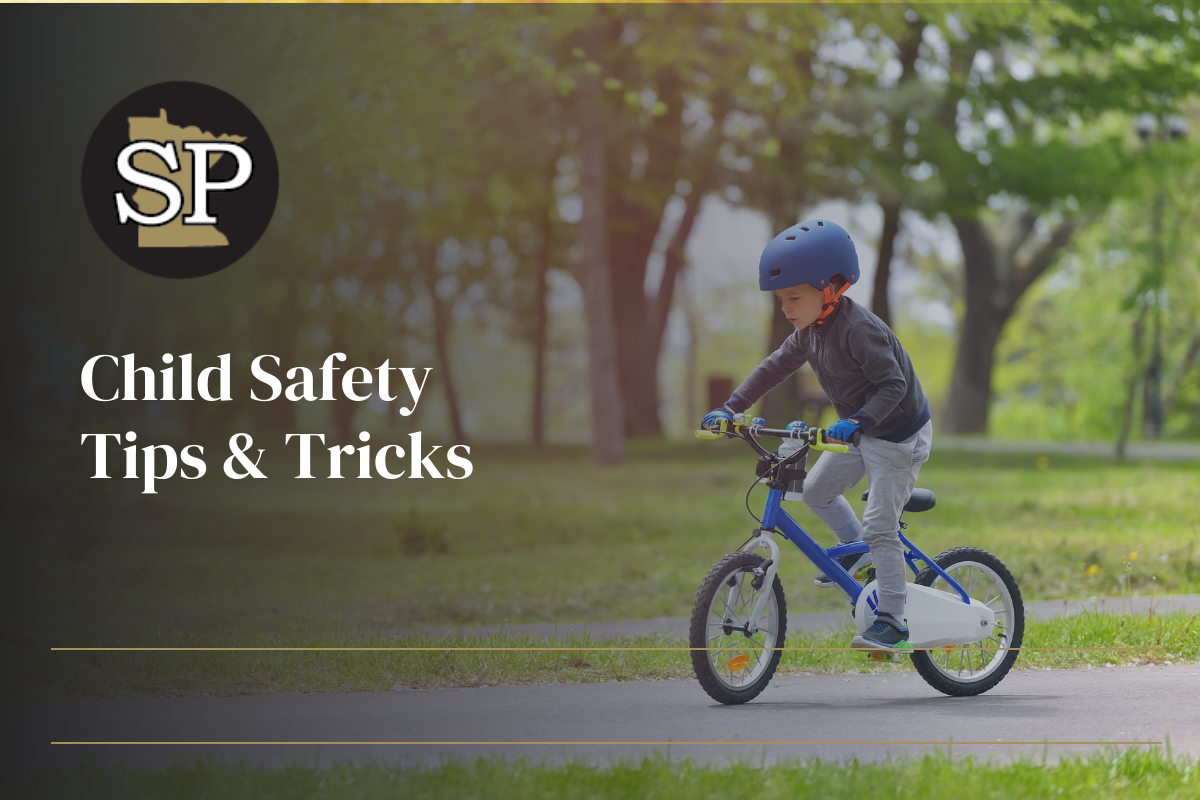
Home » Child Safety Tips
Children have a natural curiosity that can get them into trouble when they are still developing physically and mentally. They may prioritize fun over safety while lacking the ability to detect danger. The Forum on Family Statistics reports that unintentional injuries are the leading cause of death for children aged 14 and below. Accidental injuries are also a significant cause of disability and reduced quality of life in children.
Childproofing Your Home
Even your home may be filled with hazards that endanger your child’s safety. According to Stanford Medical Children’s Health, approximately 2,000 children aged 14 and under die from injuries in the home every year. The most common causes of injuries at home are:
- Fire and burns
- Suffocation
- Drowning
- Firearms
- Falls
- Choking
- Poisoning
Every room in your home presents unique safety challenges for your child, but there are numerous protective measures you can take to keep your child safe.

Kitchen Safety
The kitchen is perhaps the most dangerous room in the house for your child. Young children should only be in the kitchen with adult supervision. Even with supervision, an injury can happen in an instant due to a variety of hazards. When you have young children, plan every task and arrange your kitchen with your child in mind. Use child-proof safety latches to keep children out of cupboards and drawers. The most common hazards and methods of protecting your child are discussed below.
Fires and Burns
House fires are more likely to start in the kitchen than in any other room. Fires can start when a pan is left on the stove with a burner on, when grease gets too hot, when toast burns, or when an appliance malfunctions. In addition, children can burn themselves on hot surfaces such as a burner, the side of a toaster or toaster oven, or a hot tray. Accidents involving boiling water and hot grease can also be devastating. These fire safety tips will protect your child from fires and burns in the kitchen:
- Keep the handles of pots and pans turned inward so children cannot reach them.
- Always supervise children, especially those under 12, when cooking or doing other activities in the kitchen.
- Do not allow young children to use microwaves, toasters, blenders, or other cooking appliances unattended.
- Install stove-knob covers on stove handles if they are within reach of your child.
- Keep a working fire extinguisher and smoke detector in the kitchen.

Falling Objects
Toddlers can pull heavy or otherwise dangerous items down from high spots and injure themselves. You can prevent this by storing all items away from the edges of counters, including while you are working in the kitchen. Avoid using tablecloths or runners that your child could pull, which could lead to dishes or other heavy objects falling on them.
Children can also pull appliances on top of themselves if they can reach the cord. When working in the kitchen, check frequently for dangling cords and items near the edge of the counter, especially if they are hot or heavy.
Cuts and Punctures
Sharp kitchen items, such as scissors and knives, could seriously injure your child. Keep these items out of reach and, if possible, in a locked cabinet.
Between the ages of 6 and 12, teach children how to hold sharp utensils like knives properly. Train them using toy knives with a dull edge. Keep sharp knives, scissors, and other bladed utensils away from young children.

Preventing Falls
Children aged 0 to 4 are more likely to fall compared to older children. Some falls during childhood are expected, such as when a child is learning how to walk. However, other falls can be serious and lead to broken bones, traumatic brain injury, and long-term disabilities.
Many falls are caused by wet or greasy floors, clutter, stepladders, and children climbing to reach forbidden objects. The following tips will help you protect children from falls:
- Avoid opening windows that children could fall out of. Screens cannot protect a child from falling. Use window bars or methods to prevent the window from opening more than a few inches.
- Avoid using walkers for children who are still learning to walk above the first floor of your home.
- Use baby gates and keep them locked at the tops and bottoms of staircases.
- Never leave an infant unattended on a bed or changing table without a safety rail, even for a minute. Even if your baby has never rolled over before, there is a first time for everything.
- Avoid allowing children to climb on furniture.
Furniture
Children can hurt themselves on furniture in unexpected ways. Secure heavy furniture, such as dressers, shelving units, and tall cabinets, to a wall to prevent your child from pulling them over on themselves. If you have coffee tables or other furniture with sharp corners, install foam edge protectors to protect your child from severe head wounds or cuts.
Consider investing in cordless blinds or drapery. If your curtains and blinds have cords, keep them out of reach of your children. Long cords are a strangulation hazard.
Practice safety with your child’s furniture as well. If your child uses a stroller, high chair, or other seating device, fasten your child securely. If your child is able to unfasten themselves, it is time to stop using the item. Your child could fall trying to climb out.
Invest in a toddler bed before your child learns how to climb out of the crib. Avoid using crib bumpers, especially padded ones, as they raise the risk of suffocation for infants.
Toys
The Consumer Products Safety Commission reports that 209,500 children were treated in emergency rooms throughout the United States for toy-related injuries in 2022, and 11 died. The head and face were the most common parts of the body to be injured. Non-motorized scooters were the number one cause of injury in all age groups. From 2020 to 2022, the toys most commonly associated with death were balloons, bouncy balls, other balls, and stuffed animals.
The Consumer Product Safety Commission recommends following these precautions when choosing children’s toys:
- Follow age recommendations on the package labeling.
- Don’t allow children to play with damaged toys.
- Do not give children younger than 8 toys with glass parts or metal edges.
- Don’t give your child toys with cords or strings that could strangle them.
- Don’t let children younger than 8 have toys with sharp points.
- Don’t let children play with adult hobby items like darts.
- Don’t give infants toys small enough to fit into their mouths or with small parts that could come off.
- Discard toy packaging immediately, especially plastic wrapping and bags that could suffocate a child.
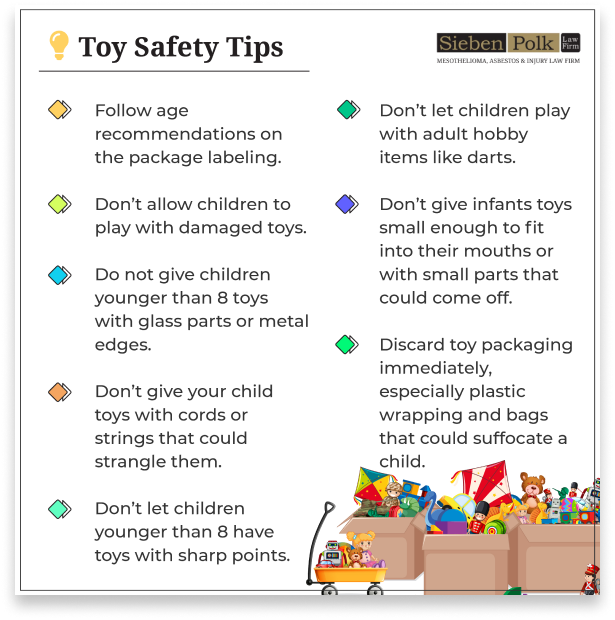
2024 Toy Recalls
Toys are commonly recalled because of lead, small pieces coming off, or failure to follow safety standards. If your child has a recalled toy, take the toy away from your child immediately and follow the manufacturer’s instructions. In many cases, you will be able to get a free replacement with the safety issue fixed. The Consumer Products Safety Commission has reported the following toy safety recalls in 2024:
- Children’s Marko Kart Ride-On Racer Car – The acceleration pedal can become clogged with debris and stay engaged when the foot is removed, creating a crash hazard.
- Nova Baby Infant Swings – These are marketed for swing babies to sleep, but the high incline can lead to suffocation; the product lacks mandatory warnings about sleeping in the swing.
- Slide & Seek Ball Runs with Wooden Knobs – The wooden knob can come off due to damage caused by defective shipping packaging.
- Fishing Games by Huihuang Trading – The magnets in the toy are too strong and could lead to bowel perforation if swallowed.
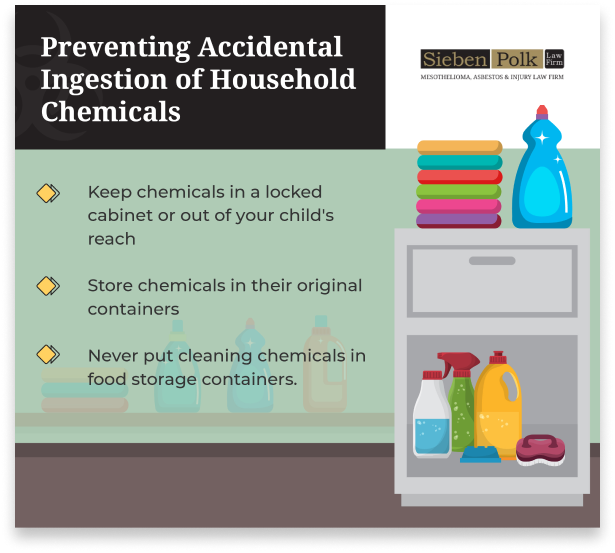
Household Products & Chemicals
Cleaning products are the second leading cause of household poisoning in children. According to the Journal of Occupational Medicine and Toxicology, 84 percent of children who experienced poisoning in a study were under 3 years of age. The products that most frequently caused serious harm were alkalis, which include drain cleaners, toilet bowl cleaners, rust removers, all-purpose cleaning agents, and oven cleaners. To prevent accidental ingestion of household chemicals:
- Keep them in a locked cabinet or out of your child’s reach.
- Store them in their original containers.
- Never put cleaning chemicals in food storage containers.
If your child ingests poison, call the poison control center in your region immediately or 911. The Minnesota Regional Poison Control Center can be reached at (800) 222-1222.
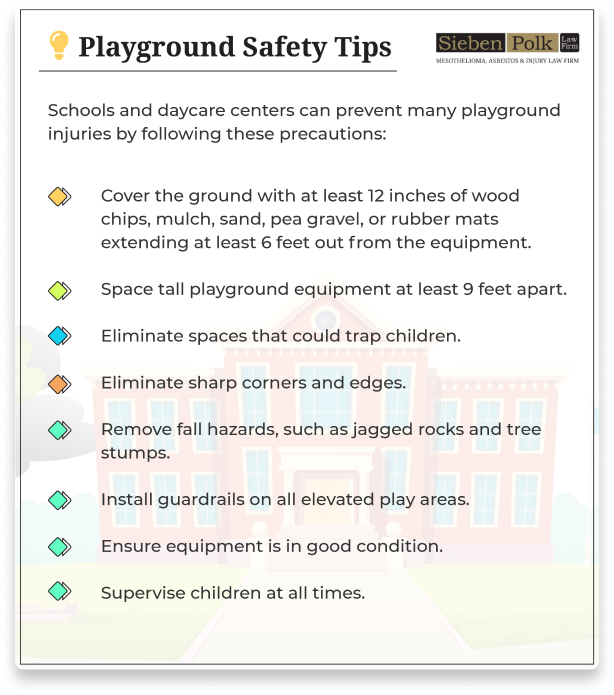
Staying Safe at School
Children can get hurt at school, preschool, or daycare if they run in the halls or are bullied by other children. They can also get hurt on the playground, the most hazardous area of most schools and daycare centers. More than 200,000 children visit hospital emergency rooms in the U.S. every year with playground injuries. Falling off of playground equipment is the most common cause.

Schools and daycare centers can prevent many playground injuries by following these precautions:
- Cover the ground with at least 12 inches of wood chips, mulch, sand, pea gravel, or rubber mats extending at least 6 feet out from the equipment.
- Space tall playground equipment at least 9 feet apart.
- Eliminate spaces that could trap children.
- Eliminate sharp corners and edges.
- Remove fall hazards, such as jagged rocks and tree stumps.
- Install guardrails on all elevated play areas.
- Maintain the equipment in good condition.
- Supervise children at all times.
Asbestos in Schools
Many school buildings were constructed before 1980, when asbestos was routinely used in construction materials. These schools may still harbor asbestos in floor tiles, drywall, ceiling tiles, and other areas. Asbestos exposure can lead to mesothelioma and other deadly diseases later in life.
The Asbestos Hazard Emergency Response Act requires school districts to inspect their buildings for asbestos and prepare management plans to mitigate asbestos hazards. Undamaged asbestos-containing materials are not considered dangerous, but if the asbestos becomes airborne, it must be removed to protect children and faculty.
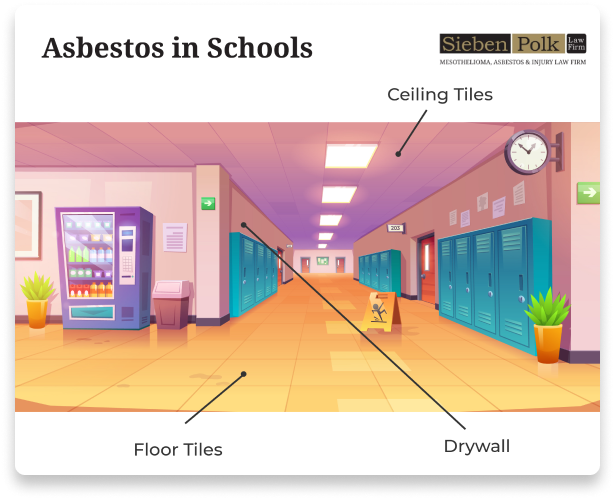
Internet Safety
The internet can be a dangerous place for children due to the prevalence of online predators, cyberbullying, drug sales, and explicit content. Keeping children safe online requires constant monitoring and alertness. Social media addiction among adolescents is a growing concern worldwide, and it has been associated with an increase in anxiety, eating disorders, substance abuse, and suicide. The following tips can help you keep your child safe online:
- Do not let your child have a computer in a private room.
- Only allow your child to use the computer in an open area of your home.
- Set limits for your child’s time online.
- Prohibit children under 13 from using social media websites.
- Teach your child how to recognize online predators and what to do if a predator targets them.
- Maintain open communication about your child’s online activities.
- If you notice changes in your child’s moods, eating habits, or personality, it could indicate social media addiction. Reach out to a therapist for help.
- Use parental controls to restrict the websites your child can view.
- Do not allow your child to keep a cell phone in their room.
Cyberbullying
According to a 2022 poll by the Pew Research Center, nearly half of U.S. teens aged 13 to 17 have experienced cyberbullying, including offensive name-calling, false rumors, receipt of explicit images, stalking, physical threats, and having explicit images of themselves shared without their consent. Teenage girls are especially vulnerable.
Your child may be experiencing cyberbullying if you notice the following warning signs:
- Changes in your child’s use of devices
- Strong emotional responses to what is happening on their devices
- Social withdrawal
- Depression
- Shutting down their social media accounts.
Cyberbullying can lead to severe depression, anxiety, and suicide. If you suspect your child has experienced cyberbullying, talk to your child and reassure them that you are on their side. Report the bullying to law enforcement if it continues, and work with your child to engage with positive content online to shift the focus.
Playing Sports Safely
Approximately 3.6 million people were treated in emergency rooms in the United States in 2022 from injuries related to sports and recreational equipment. Sports injuries most commonly occurred during exercise, cycling, and basketball. Children aged 5 to 14 were the most commonly injured.
Protective Equipment
Require your child to wear well-fitting equipment designed for the sport. The following protective equipment can prevent sports injuries:
- Helmets
- Elbow and knee pads
- Mouth guards
- Properly fitting athletic shoes
- Ankle stabilizers
- Shoulder pads
- Thigh pads in contact sports
- Jockstraps
- Eye and ear protection
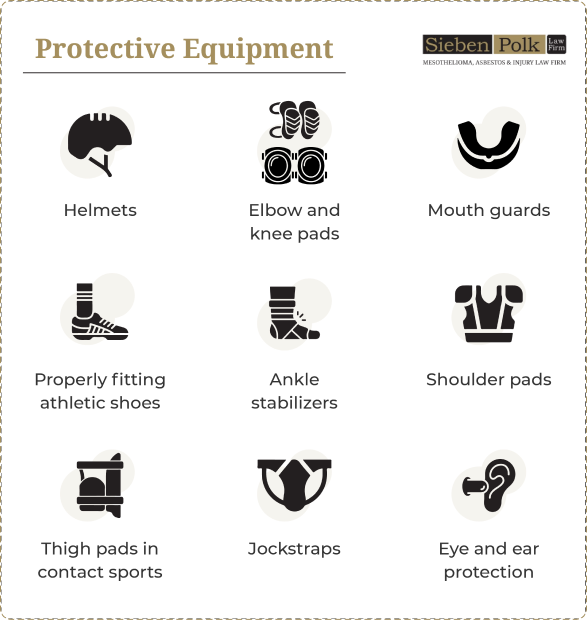

Hydration and Heat Stroke
Excessive heat and dehydration can lead to serious heat-related illnesses. Children have a harder time cooling themselves than adults because they sweat less. Allow them to adjust to hot weather gradually. One way to ensure your child has had enough fluids is to weigh them before and after playing. If your child’s weight is lower after playing, your child did not consume enough fluids.
Never restrict fluids during practice, and have an emergency plan in place in case medical services are needed. Adjust practice intensity in hotter and more humid conditions.
A medical professional should be present to monitor children playing sports in hot and humid weather. Encourage frequent drink breaks. If a child becomes irritable or complains of dizziness, headache, or cramps, it could be a sign of dehydration. Provide hydrating fluids immediately and move the child to a cooler area until symptoms pass.
Heat cramps can be intensely painful and are another sign of dehydration. A sports drink can help replace electrolytes and relieve symptoms. Once the cramps disappear, children can return to play.
Heat Exhaustion
Failure to treat early dehydration symptoms can lead to heat exhaustion, resulting in more severe symptoms, such as diarrhea, vomiting, intestinal cramps, and fainting. Move the child to a cooler area immediately, remove excess clothing, provide hydrating fluids, and use fans to keep them cool. If symptoms do not rapidly improve, seek prompt medical attention.
Prohibit children suffering from heat exhaustion from playing in the sun and heat the rest of the day. They need rest.
Heat Stroke
Heat stroke is a serious and potentially fatal complication that occurs when the core body temperature increases too quickly. Symptoms may include:
- Loss of consciousness
- Seizures
- Confusion
- Vomiting
- Weakness
- Dizziness
- Rapid breathing
- Rapid heart rate
- Dehydration
Seek medical attention immediately and keep the child cool until help arrives. Wait for the doctor’s approval before letting the child return to play.

Child Safety on the Road
Motor vehicle crashes are a leading cause of death in children. Statistics from the National Highway Traffic Safety Administration show that among children aged 14 and under in the U.S. in 2021:
- 1,184 died in traffic fatalities.
- 162,298 were injured.
- 863 of the children who died were riding in passenger vehicles.
- At least 308 of the children who died were unrestrained.
Appropriate restraints save lives and prevent injuries in children in car accidents. Rear-facing car seats are safest. These are required for infants, but some can seat children for up to 2 years.
Keep your child in a rear-facing car seat until they reach the maximum weight for the seat, and then switch to a forward-facing car seat until your child outgrows it.
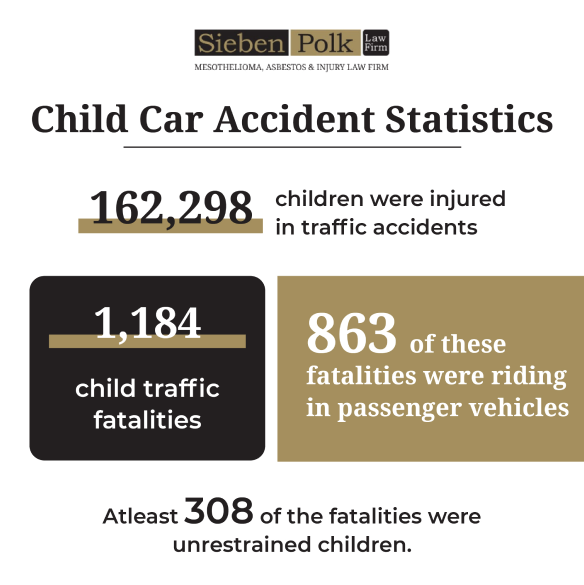
The next step is a booster seat until your child is big enough to wear an adult seat belt. This occurs when your child can sit back in their seat with their feet flat on the floor.
Remind your child to wear their seat belt properly. It offers little to no protection when under the arm. Improper use can be a hazard in the event of an accident.

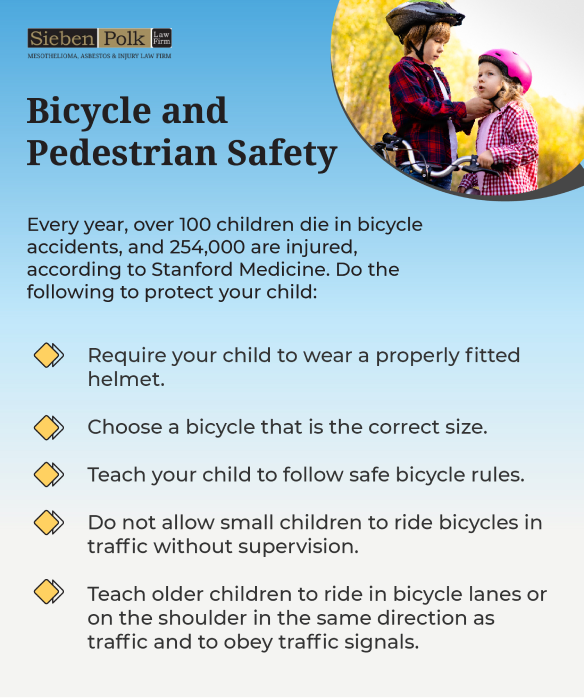
Bicycle and Pedestrian Safety
Every year, 100 children die in bicycle accidents, and 254,000 are injured, according to Stanford Medicine. Do the following to protect your child:
- Require your child to wear a properly fitted helmet.
- Choose a bicycle that is the correct size.
- Teach your child to follow safe bicycle rules.
- Do not allow small children to ride bicycles in traffic without supervision.
- Teach older children to ride in bicycle lanes or on the shoulder in the same direction as traffic and to obey traffic signals.

The National Highway Traffic Safety Administration recorded 176 child pedestrian deaths in 2021. Accompany young children. If your child walks to school, walk with them the first few times until they have established reliably safe walking habits. Have your child walk with a group and follow these safety practices:
- Walk on sidewalks only.
- If there is no sidewalk, walk facing traffic. Only older children should be allowed to walk alone in these situations.
- Avoid strangers. Walk with friends and refuse to talk to unknown persons. Walk in the opposite direction if a stranger approaches.



Staying Safe Around Water
Drowning is the leading cause of injury-related death in children aged 1 to 4. Children can drown in as little as 2 inches of water. Whether your child is taking a bath or swimming, follow the guidance below to keep them safe:
- Never take your eyes off your child when they are in the water.
- Empty your backyard pool when not in use.
- Designate someone to watch the children during parties and group events.
- Keep your pool securely fenced and lock the gate.
- Teach your children how to swim while young while continuing to supervise them near water over time.
- Learn CPR.
- Cover pool and jacuzzi drains, repairing malfunctioning drains so small children do not get stuck on them.
- Give your children plenty of fluids while swimming to avoid dehydration.
When boating, require your child to wear a properly-fitted U.S. Coastguard-certified life jacket. Set an example by wearing one yourself.
Children are more likely to get hypothermia than adults. Bring warm clothing and blankets to cover your child if they get cold. Bring safe alternative entertainment for your child so they don’t get bored on the boat.
